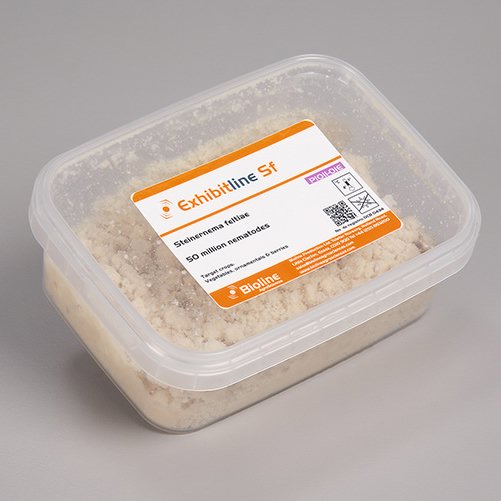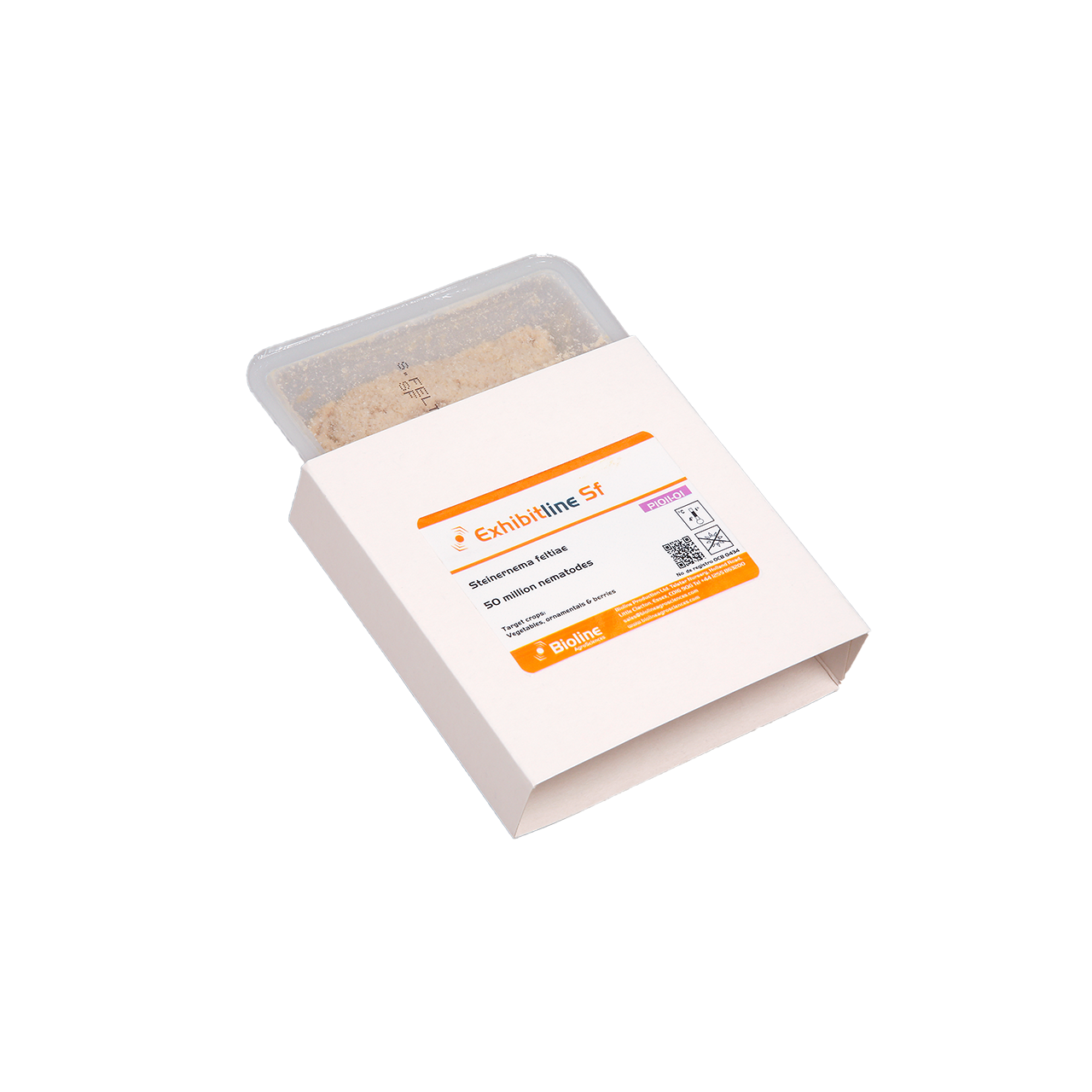Западно цветочный трипс (Frankliniella occidentalis);
Табачного трипса (Thrips tabaci);
Грибные комарики (Lycoriella ingenua и Bradysia paupera);
Мухи-береговушки (Scatella tenuicosta);
Проволочник (Hemicrepidius hirtus);
Капустянки / медведки (Gryllotalpa gryllotalpa);
Скосарь одиночный (Otiorhynchus sulcatus);
Все вредители, стадии развития которых, проходят в почве.
Овощные и цветочно-декоративные культуры открытого и защищенного грунтов, плодово-ягодные культуры, грибное производство, розы на срез, культуры на гидропонике, используется в сити-фермерстве.
Лоток 60 мл - 50 миллионов
Лоток 300мл – 250 миллионов
Упаковка 5 лотков по 250 миллионов
Nematodes infect all pest instars but the egg. They control more than 1000 pest types. A wide range of pests is due to the highly pathogenic properties of symbiotic bacteria.
Nematodes are simple roundworms and may be free-living in the soil in different climatic zones. Entomopathogenic nematodes are extraordinarily lethal to many important insect pests, yet are safe for people, birds, plants, and animals. This high degree of safety means that unlike chemicals, nematode applications do not require masks or other safety equipment. In agriculture, nematodes are used for production of champignons, potato, cabbage, greenhouse cucumber, ornamental crops, including rose.
Lepidoptera:
Diptera:
Coleoptera:
Thysanoptera:
Entomopathogenic nematodes are adapted to low temperatures. They can infect and kill pests at 10 ℃. The temperature range for the infectious activity is from 10 to 25 °C. These beneficials work most effectively in the temperature range from 15 to 20 °C. Roundworms can finish the life cycle at a temperature from 12 to 30 °C. Nematodes are successfully used within a narrower temperature range in the autumn and spring season.
Nematodes detect their victim by chemical metabolic signals, a gradient of carbon dioxide concentration, and react to substrate vibration from future prey. Infective juveniles (nematodes) actively penetrate the host’s body through the oral, anal, or stigmal holes. In favorable conditions, such instars as mature, larva, nymph, or prepupa of insects are affected. Then, getting into the hemocoel, they release a colony of pathogenic bacteria from their intestinal tract which is preserved in the intestine of the free-living nematode. Nematodes and bacteria stimulate each other’s reproduction in the host. Bacteria secrete siderophores and antibiotics that prevent proliferation of other pathogenic and rotten microorganisms. Being infected, pests die within 1 – 2 days. The amino acid bouillon, obtained from internal organs in the victim’s body cavity, serves as a nutrient solution for nematode larvae. In 3-4 days, the larvae turn into mature individuals, and the females lay eggs after mating. The 1st instar larvae hatch inside the female’s body. Already on the 5th day, a new generation of infective juveniles appears. Each gram of host mass accumulates up to 1.5 million infective juveniles. There are possible several life cycles of an entomopathogenic nematode in the large victim’s body. Insects killed by most steinernematid nematodes become brown or tan. That is why nematode is well fixed in the ecosystem and controls instars of the soil pest for quite a long time.
The life cycle consists of 3 developmental instars: egg – larva (stage I-II-III-IV) – mature (female or male). The 3d instar carries out the releasing function and host’s infection one. This juvenile instar can survive
in unfavorable environmental conditions, temporarily transforming into a dauer – instar. S. feltiae develops without metamorphosis. The transition between instars takes place in the process of molting.
Female. Length is up to 1 mm. The cuticle is smooth. Lip region rounded or truncate with six lips, each with one labial papilla at its tip. Esophagus short in relation to body size. Uterus and spermatheca located centrally between vulva and flexure, ovaries located dorsally beyond flexure, terminating ventrally in an opposite body half.
Male. Much smaller than the female. Body length is 0.8-1 mm. The cuticle is smooth, spicules are slightly curved, their length 60-65 um. Cuneus is short, not reaching the posterior end of the corpus. Eleven pairs and one large ventral pre-anal genital papillae present. Tail tapering to rounded body terminus with fine, long mucron. Bursa absent.
Infective juveniles. The body is slender, tapering regularly from the base of esophagus to anterior end and from anal area to the tail terminus. Body length is 750-920 um, width is 22-27 um. Cuticle with indistinct transverse annulation. Lip region smooth, generally not set off. Protostom-telostom is triangular in shape anteriorly, stoma length is 1.32 um. The excretory duct is long. A pouch of bacteria enclosed by the intestinal wall immediately below cardia. Its length is 18 -37 um. Tail conical with pointed terminus.
Requirements for plant spraying equipment
1. Wet the soil well a few hours before application;
2. Spread the solution evenly all over the surface with nematodes, avoiding the appearance of leaks;
3. Dosage for application: 0.5 million nematodes/m²;
4. The amount of liquid for treatment depends on the application method and the soil type;
5. Maintain the area to be wet for two weeks after application;
Moisture treatments with nematode on plants
• moisture soil or substrate;
• soil temperature in the range of 10 to 30 °C;
• nematodes die from ultraviolet rays and drying out;
• moisture leaf treatments should be done in the evening to keep the plants wet as long as possible and the amount of UV light to be minimal;
The entomopathogenic nematode Steinernema feltiae (the 3d larval instar) is supplied in packaged form in a state of anabiosis. These containers should be kept in a dark place at low temperatures of 2-6 °C. The storage duration is marked on the package.
The given dosages are approximate. Contact our technologists or distributors for individual advice. Having understood your climatic conditions, vegetation time, carried out treatments, kind of crop, and level of infestation, we will give more precise recommendations.
At present most agricultural producers use pesticides. The problem of pest resistance to poisons is becoming more serious. Bioprotection solves this problem, but in rare cases transition to such type of protection occurs at the initiative of the team (why?). Most often this is a forced measure due to a decrease in production indicators or a complete failure of the chemical protection strategy. The transition from chemical to biological pest control methods is complicated by the long decay period of certain pesticides. Steinernema feltiae is compatible with most insecticides and acaricides and suites for the transition period as an insecticide for wet treatments of the crop.
Steinernema feltiae совместима с большинством инсектицидов и акарицидов, поэтому идеально подходит для переходного периода, как инсектицид для влажных обработок культуры.
Наиболее активны нематоды Steinernema feltiae на личинках почвенных комариков (отряд Diptera, семейство Sciaridae). На практике они используются для защиты от грибных комариков на шампиньонах и других культивируемых грибах. И в борьбе с почвенными комариками в теплицах и оранжереях для защиты тепличных огурцов и горшечно-цветочных культур.
Энтомопатогенная нематода Steinernema feltiae высокоэффективна против важнейших вредителей шампиньонов: Lycoriella mali, Lycoriella auripila, Megaselia halterata, Megaselia nigra, Heteropeza pygmaea, Mycophila speyeri и Mycophil barnesi. Нормой внесения на 34 кг субстрата считается 3 миллиона инвазионных личинок. Вносить необходимо вовремя гобтировки покровным материалом. При норме внесения 1 миллион нематод/м2 для борьбы с комариком Lycoriella auripila (Diptera: Sciaridae) при внесении через 1 сутки после гобтировки обеспечивает 97 % эффективность против 1-го поколения вредителя. При повторном внесении нематоды в той же концентрации через 7 суток после гобтировки обеспечивается 95 % эффективность поражения 2-го поколения вредителя.
На горшечной культуре пуансеттии против личинок 2-4 возрастов почвенного комарика Bradysia coprophila нематода Steinernema feltiae проявляет более высокую эффективность, чем Steinernema carpocapsae. Для мониторинга эффективности применения можно использовать диски, вырезанные из картофельных клубней.
Западного цветочного трипса Frankliniella occidentalis чувствительны к различным штаммам нематоды Steinernema feltiae. Наибольшая вирулентность проявляется при высокой влажности почвы, но снижается при более сухих почвенных условиях. При инфекционной нагрузке 400 нематод на каждый см2 субстрата (0,4 миллиона на 1м2) всегда наблюдается высокая смертность трипса для всех его почвенных стадий независимо от влажности. Более низкие нормы применения нематоды 200 нематод/см2 вызывают лишь 30-50% смертности западного трипса.
У томатной совки-карадрины Spodoptera exigua в чашках Петри при инфекционной нагрузке от 50 и более инвазионных личинок Steinernema feltiae на 1 гусеницу – погибало 91-100 % особей.
Активность нематоды Steinernema feltiae относительно представителей отряда Coleoptera изучена на примере колорадского жука Leptinotarsa decemlineata. В лабораторных условиях при инфекционной нагрузке более активно инвазировались личинки жука 4-го возраста. В течении 24 часов погибли более 70% личинок фитофага.


Оставить комментарий